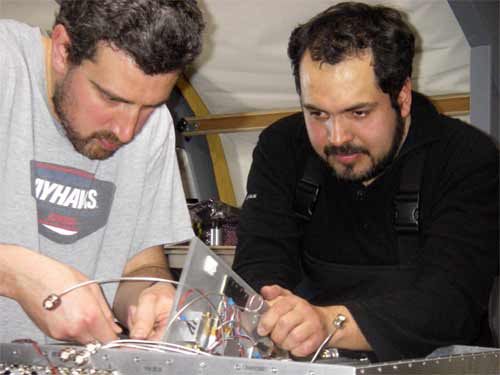Trekkers,The CReSIS team had their first official radar flight from Byrd Surface Camp yesterday, December 22, 2009. CReSIS team members Fernando Rodriguez - Morales and Cameron Lewis, along with pilot Lexi Larson and co-pilot Lee Thomas took off into beautiful blue skies.
 Airplane
Airplane
 Airplane 2
Airplane 2
 Airplane 3
Airplane 3
They were gone about 7 hours gathering data with the three different radars. Upon their return everyone on the team went to work. Polar Grid team members Chad Brown and Keith Lehigh began the process of backing up the data. Meanwhile the rest of the team discussed what in-flight modifications and adjustments had to be made with the radar systems during the flight. After dinner the team, having looked at some of the data results determined that something was not functioning in one of the radars. Fortunately this team is well prepared with two of each system and boxes and boxes of spare parts. It was amazing to watch. As a table was set up in the science tent and someone was pulling out the second system, two people were removing parts of the systems located in the plane. At the same time individuals were outside, where our cargo is located, going through the hard case boxes looking for the needed parts. All of this was occurring after 10:00PM with temperatures of -3 decrees F.
Then I watched the scientific process in action.
The question: What were the possible causes of the problem?
 Carl Leuschen looks at early views of the data collected.
Carl Leuschen looks at early views of the data collected.
The hypothesis: They determined which of the possibilities would be the most likely?
 Fernando, Cameron, Logan,and Carl working through the process.
Fernando, Cameron, Logan,and Carl working through the process.
Procedures: Plans were made for what equipment was needed, how the control would be set up, and in what order each component would be tested, always double checking that they were not testing more than one factor.
Data collection: During this phase the procedures were followed with each member of the team working together toward the common goal.
Evaluation: After each test an assessment was made of their hypothesis.
Was that the cause of the problem? If it was not the process began again.
 Carl and Fernando testing their hypothesis.
Carl and Fernando testing their hypothesis.
Now Trekkers, when you do use this process in school you write out each and every step. Your teachers are looking to see if you understand the process. What I witnessed were six men, who long ago sat in chairs much like the ones in your schools today and wrote out many hypotheses and procedures, working to solve a problem without having to even think about the process. They instinctively know that they have to look at one factor at a time. They test one idea at a time. They discuss and listen to each other's ideas and suggestions. In the end, at 3:00AM, the problem was repaired; the radar equipment was loaded and secured into the plane; and several tired scientists headed to tent city to go to bed. Two of them would be up in less than 4 hours to be ready to evaluate the weather to prepare to fly another mission, which also took off in beautiful blue skies. This is Antarctica though and within two hours they were back at camp for the weather less than 100 miles away was causing ice to form on the plane.
 Safety is alway first!!
Safety is alway first!!
Safety is the most important thing in any science work whether it is in the field, in a lab, or in your classroom.
Keep working in your science classes. Prove to your instructors that you understand the process. Practice good safety habits. Be scientists in your classroom lab for someday you could be in a remote field situation where you will call upon those lessons from your past and put them to great use.
 St. Regis Students in the Lab
St. Regis Students in the Lab
 St Regis Students,Whitney and Jillian, working the process.
St Regis Students,Whitney and Jillian, working the process.
 St Regis student, Preston, hard at work.
St Regis student, Preston, hard at work.
 St. Regis student Ben practicing.
St. Regis student Ben practicing.
 Just like Dan of St. Regis keep working at the process!
Just like Dan of St. Regis keep working at the process!
Proudly teaching science to future scientists of the world,
Mr. W

